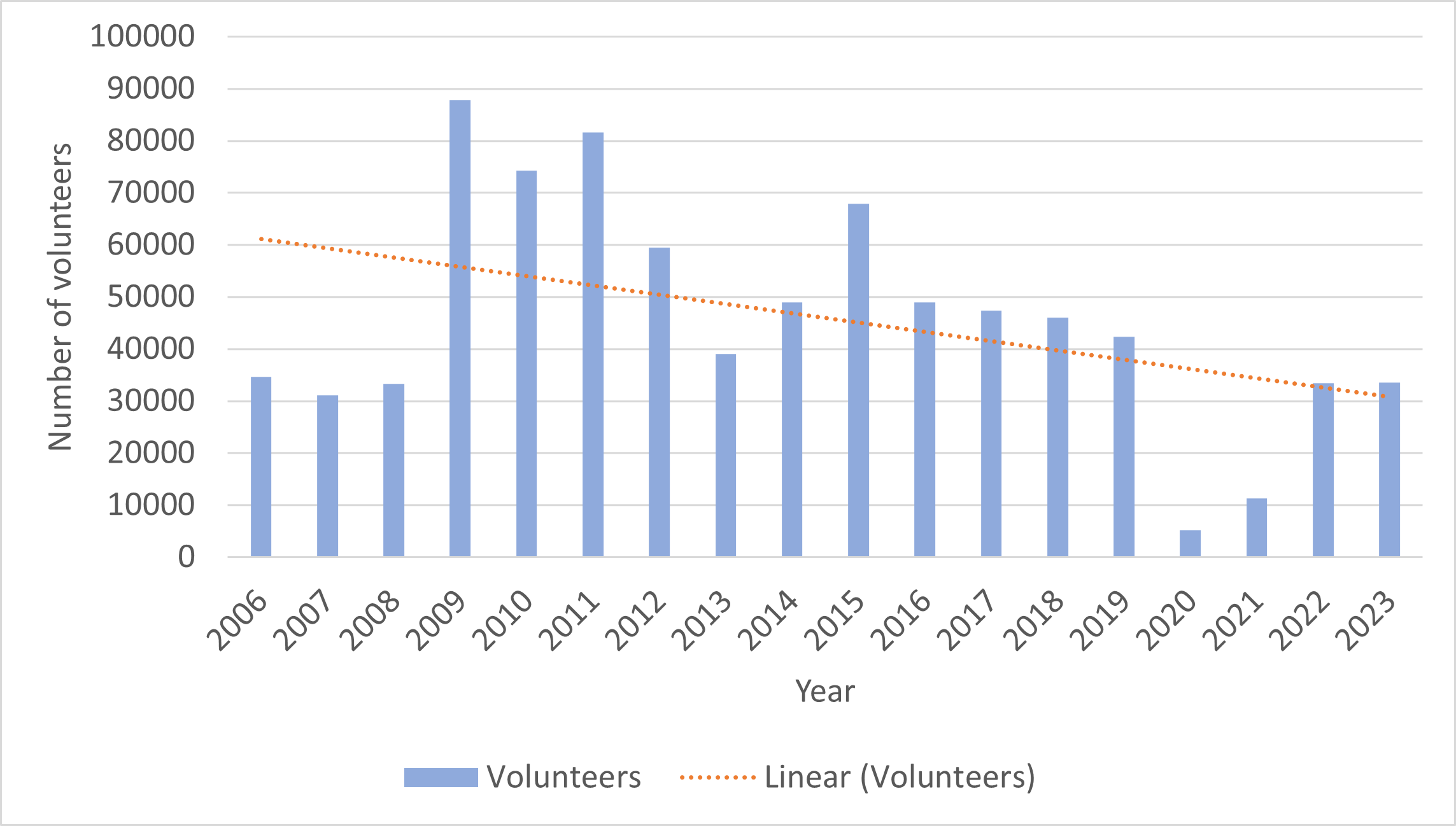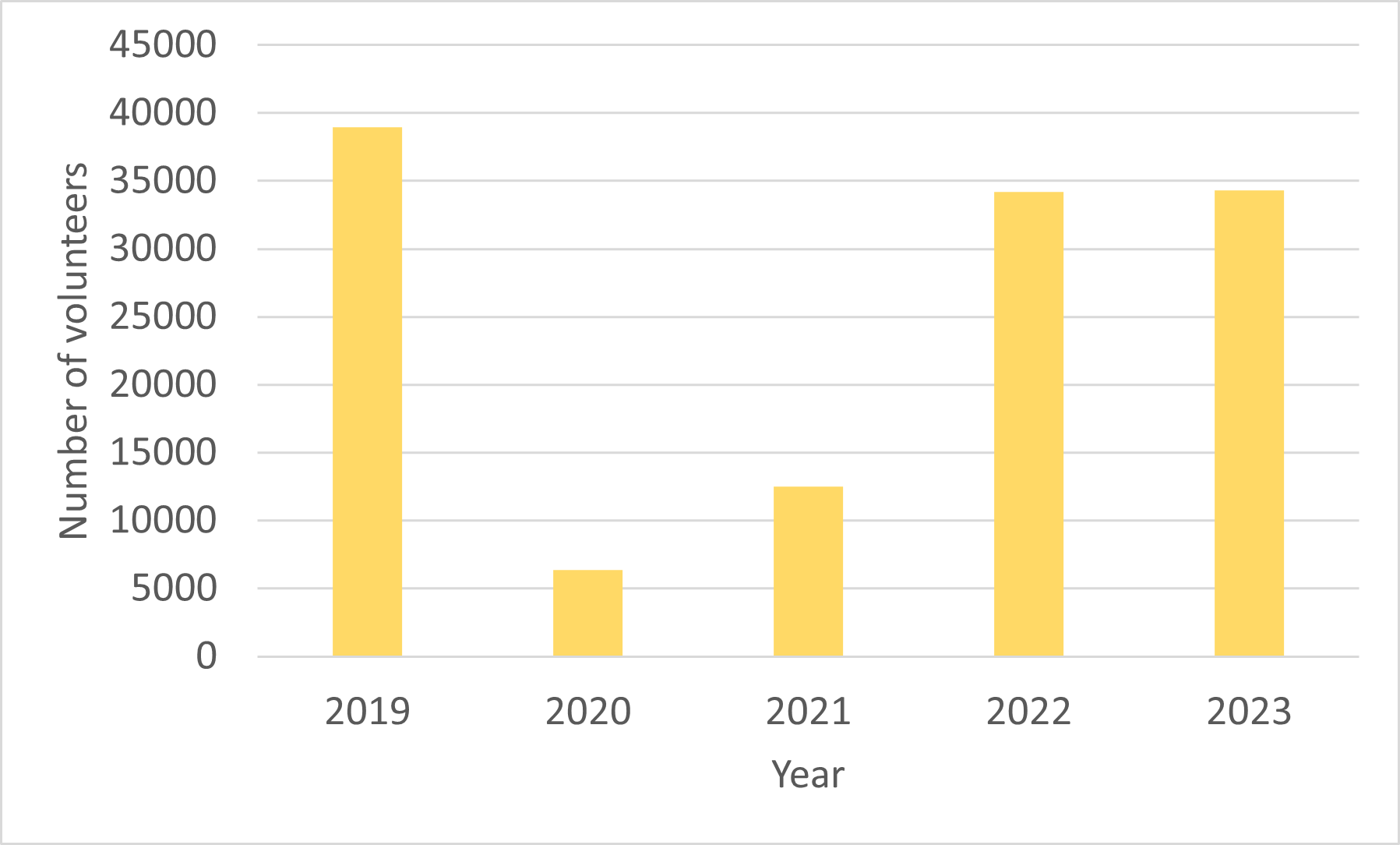This indicator presents an index of the number of people volunteering to conserve Ontario’s biodiversity and provides a means of assessing trends in the level of public participation in biodiversity conservation in the province.

Figure 1. Number of people volunteering to conserve biodiversity in Ontario, 2006-2023. (Source: Nature Conservancy of Canada, Ducks Unlimited Canada, Conservation Ontario, Ontario Nature, Ontario Federation of Anglers and Hunters, and Ontario Stewardship) (Note: Data for Ontario Federation of Anglers and Hunters started in 2010. Data for Ducks Unlimited Canada and the MNR’s Resources Stewardship Program were based on financial years rather than calendar years. Financial year data was assigned to the first calendar year. Data from MNR’s stewardship program ended in 2013).

Figure 2. Number of people volunteering to conserve biodiversity in Ontario 2019-2023 with Carolinian Canada and Watersheds Canada.

Figure 3. All organizational volunteers from 2019-2023.
Status:
- Between 2006 and 2023, the number of people who volunteered with select conservation organizations to conserve Ontario’s biodiversity decreased from 34,697 to 33,491, representing a 3% decrease, with much variability from year to year. The rate of increase from 2006-2019 (prior to the pandemic) was 22%. During the COVID-19 pandemic volunteer efforts decreased significantly, numbers have increased since however they have not reached pre-pandemic numbers as of yet. With the data collection over long periods of time, some of this can be attributed to a refinement in reporting activities.
- When including all organizational volunteers from 2019 to 2023 volunteer numbers decreased by 12% , from 38,931 to 34,288.
Data on the number of volunteers working to conserve biodiversity was provided by four conservation organizations — Nature Conservancy of Canada, Ducks Unlimited Canada, Ontario Nature, the Ontario Federation of Anglers and Hunters and various public bodies — Ontario Ministry of Natural Resources’ (MNR) Ontario Stewardship Program, and 36 conservation authorities in Ontario. This indicator was first presented in 2015, with some data going as far back as 2006[1] (Figure 1). Though it is not a comprehensive list of all volunteersa cross the province it is an index of the number of people volunteering to conserve biodiversity in Ontario.
For this report, additional organizations — Watersheds Canada and Carolinian Canada have provided volunteer data for 2019-2023. These results can be found in Figure 2.
For the purposes of this indicator, volunteering for biodiversity conservation included any activity undertaken by an organization, community or individual to further the understanding, protection or enjoyment of the natural environment; enhance, restore or rehabilitate native habitat or species; or support the organization or administration of biodiversity conservation activities between the years 2006 and 2023. It does not include membership in the select conservation organizations.
NOTE: Data from 2002 to 2018 is limited to the data available through the previous indicator. Additional organizations have been included after 2019 which can be found in Figure 2. Data going forward from those data included more organizations and activities, including aquatic ecosystems.
[1] OFAH data started in 2010, MNR’s Ontario Stewardship Program ended in 2013.
Atlantic Salmon were extirpated from Lake Ontario over 120 years ago. As part of their restoration, the Bring Back the Salmon initiative runs a classroom hatchery program in classes across the Lake Ontario basin. The program consists of classes receiving 100 Atlantic Salmon eggs in January and raising them until they are released by students in a local restoration stream in May/June. This 5-month hands-on science lesson provides a local, real-world example of the consequences of negative environ…
Read MoreLake Ontario used to be home to a thriving population of Atlantic Salmon (Salmo salar). The Lake Ontario Salmon Habitat Restoration Program works to bring this species, part of Ontario’s rich biodiversity, back to the lake. The Program has four components: fish production and stocking, water quality and habitat enhancement, outreach and evaluation, and research and monitoring. One effort to support restoring Atlantic Salmon to Lake Ontario was a bank stabilization project in Cobourg. The site,…
Read MoreJoan and Gerald Donnelly have lived on their 100 acre farm just outside of Mono Mills for 42 years, on land now designated part of the Niagara Escarpment. The couple believes in creating and protecting habitat for birds and other wildlife on their farm, having installed many bluebird, wood duck and bat boxes around their property. They’re also willing to share their barn with the swallows every year, despite the clean-up that is needed at the end of each season. Not only do the Donnellys provi…
Read More



